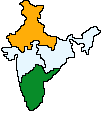| Table of contents |
| Geographical Position |
| Demographic Profile |
| Constitution |
| Poltical System |
| Judicial System |
| Climate |
| National Emblem |
| Indian Flag |
| National Song |
| National Flower |
| National Tree |
| National Fruit |
| National Calender |
| National Animal |
| National Bird |
| Currency |
| National Anthem |
| National Language |
| National Sports |
| Indian Culture |
|
Indian History in Comics |
| Visit India |
| Discussion board |
| Indian Festivals |

|
India is a country of ancient times and unlimited natural resources. The rivers, mountains and vegetation, not to forget its exotic spices, make the country a wonderful place to visit.

Mark Twain once said: "So far as I am able to judge, nothing has been left undone, either by man or nature, to make India the most extraordinary country that the sun visits on his rounds. Nothing seems to have been forgotten, nothing overlooked."
Geographical Position Of India

|
The Indian subcontinent is in Asia. It is a peninsula and the three sides are surrounded by Arabian Sea in the south west, Bay Of Bengal in the south east and Indian Ocean in the
South. It lies to the north of Equator between 68.7 to 97.25 degrees north longitude and 8.4 to 37.6 degrees east latitude. India measures 3214 kms from north to south and 2933 kms from east to west. It has a land frontier of 15,200 kms and a coastline of 7516.5kms. India shares its political borders with Pakistan and Afghanistan on the west, Bangladesh and Burma in the east, Nepal, China, Tibet and Bhutan in the north.
|

Demographic Profile:
Area : It covers an Area of 3,287,263 sq. km
Capital : New Delhi
Population :India is the second largest populated country in this world after China .
| Population(July 1999 est.) |
1,000,848,550 |
| Population (1991 census) |
846.3m |
| Sex Ratio |
At birth: 1.05 male(s)/female
Under 15 years: 1.06 male(s)/female
15-64 years: 1.08 male(s)/female
65 years and over: 1.03 male(s)/female
Total population: 1.07 male(s)/female (1999 est.)
|
| Population growth rate |
1.68% (1999 est.) |
| Decennial Population Growth Rate for 1981-91 |
23.85% |
| Urban Population (1994) |
26%. |
| Population Density |
273 persons per sq km |
Infant mortality rate: 60.81 deaths/1,000 live births (1999 est.)
Birth Rate : 25.39 births/1,000 population (1999 est.)
Death Rate :8.5 deaths/1,000 population (1999 est.)
Literacy:(Definition: age 15 and over can read and write) (1995 est.)
- Total population: 52%
- Male: 65.5%
- Female: 37.7%
Economy statistics :
| Percentage of population below Poverty Line(1994 est.): |
35% |
| National Income (at current prices): |
Rs 473,246 crores (‘91-’92) |
| GDP: purchasing power parity : |
US Dollar 1.689 trillion (1998 est.) |
| GDP - real growth rate: |
5.4% (1998 est.) |
| GDP - per capita: purchasing power parity : |
US dollar 1,720 (1998 est.) |
| GDP - composition by sector:(1997) |
Agriculture: 25%
Industry : 30%
Services: 45%
|
| Per capita NNP (at current prices): |
Rs 6929 (‘93-’94) |
| External Debt (1998) : |
US dollar 93 billion |
| Net Market Borrowing (‘95-’96 budget estimate)
: |
Rs 27,087 crores |
| India's Total Exports |
US dollar 32.17 billion (f.o.b., 1998) |
| India's Exports Commodities |
Textile goods, gems and jewelry, engineering goods, chemicals, leather
manufactures |
| Exports—partners: |
US 19%, Hong Kong 6%, UK 6%, Japan 6%, Germany 5% (1997) |
| India’s Total Imports: |
US dollar 41.34 billion (c.i.f., 1998) |
| India’s Imports Commodities: |
Crude oil and petroleum products, machinery, gems, fertilizer, chemicals |
| Imports-partners: |
US 10%, Belgium 7%, UK 7%, Germany 7%, Saudi Arabia 6%, Japan 6% (1997) |
Economic Aid:Recipient
| *US dollar 1.237 billion (1993) |
| *US dollar 171million |
| * US dollar 680 million |
| * Western non US countries, ODA bilateral commitmentsUS dollar 2.48 billion |
| * OPEC bilateral aid US dollar 200 million |
| * World Bank (IBRD) multilateral commitments US dollar 2.8 billion |
| * Asian Development Bank (AsDB) Multilateral commitments US dollar 760 million |
| * International Finance Corporation (IFC) multilateral commitments US dollar 200 |
| * Other multilateral commitmentsUS dollar 554 million(1995-96)
|
| Economic survey 1998-99 Highlights |

Constitution of India

The constitution of India is the second biggest in the world. The biggest constitution is that of Ireland. Our constitution consists of Parts, Schedules and the Preamble.
|

Political System Of India

Federal System
India, a union of states, is a Sovereign, Secular, Democratic Republic with a
Parliamentary system of Government. The Indian polity is governed in terms of the Constitution, which was adopted by the Constituent Assembly on 26 November 1949 and came into force on 26 January 1950.
The President is the constitutional head of Executive of the Union. Real executive power vests in a Council of Ministers with the Prime Minister as head. Article 74(1) of the constitution provides that there shall be a Council of Ministers headed by the Prime Minister to aid and advise the President who shall, in exercise of his functions, act in accordance with such advice. The Council of Ministers is collectively responsible to the
Lok Sabha, the House of the People.
In the states, the Governor, as the representative of the President, is the head of Executive, but real executive power rests with the Chief Minister who heads the Council of
Ministers. The Council of Ministers of a state is collectively responsible to the elected legislative assembly of the state.
The Constitution governs the sharing of legislative power between Parliament and the State Legislatures, and provides for the vesting of residual powers in Parliament. The power to amend the Constitution also vests in Parliament.
The Union Executive consists of the President, the Vice-President and Council of Ministers with the Prime Minister at the head to aid and advise the President.
|

Judicial System of India

The Judicial system comprizes of Supreme court, High courts and Lok adalats. The Supreme Court is the apex court in the country. The High Court stands at the head of the state's judicial administration. Each state is divided into judicial districts presided over
by a district and sessions judge, who is the highest judicial authority in a district. Below him, there are courts of civil jurisdiction, known in different states as munsifs, sub-judges,
civil judges and the like. Similarly, criminal judiciary comprises chief judicial magistrate and judicial magistrates of first and second class.
|

Indian Flag
Tricolour
 |
The flag is a tricolour . All the
three colours have a great significance. The three colours are at the top,
saffron ("kesari") ,in the middle white, and at the bottom, green in equal
proportion . The ratio of the width of the flag is two to three. There
is a navy blue wheel, ("chakra") in the white band. The wheel , ("chakra") consists
of twenty four spokes .Its design is that of the wheel which appears on
the abacus of Sarnath Lion Capital of Ashoka. The colours of the flag stand for the 4 P's :
At one time it was also depicted as Bapuji's charkha.
Design of the national flag was adopted by the constituent Assembly on 22 July 1947. Its use and display are regulated
by a code.
Ace banners and Flags |



|




